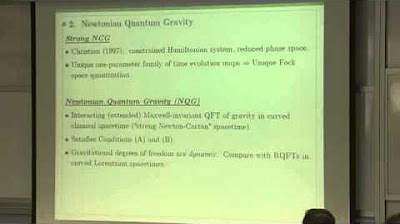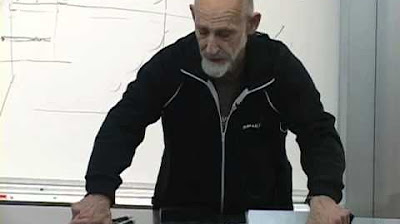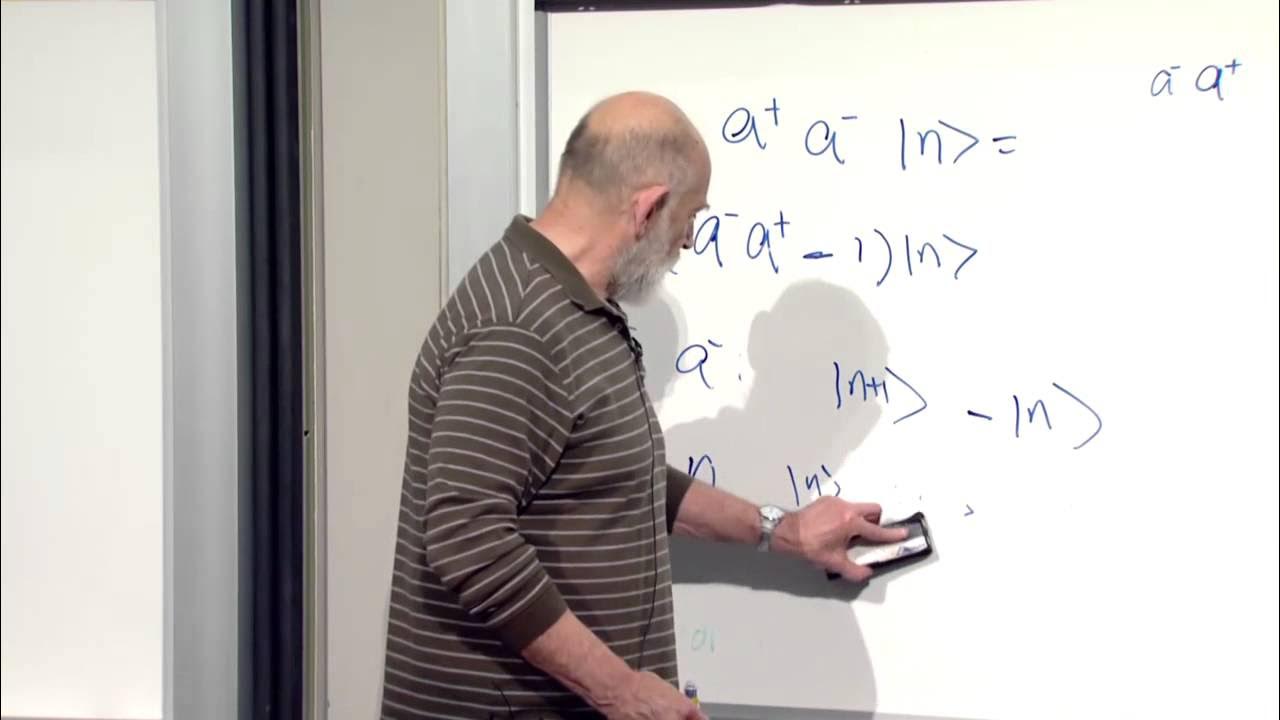Benjamin Feintzeig: Classical limits of particle concepts in quantum field theory
TLDRThe speaker explores the concept of particles in quantum field theory, addressing the limitations of localized particle interpretations. They introduce David Wallace's unpublished work suggesting particles as emergent phenomena and delve into the classical limit of quantum field theories to investigate particle-like concepts. The talk discusses the technical development of strict quantization and its potential for understanding the emergence of particles, concluding with partial results that propose new insights into particle interpretations without relying on traditional representational methods.
Takeaways
- 📚 The speaker aims to address the negative perceptions in quantum field theory regarding particle localization and interpretation by exploring a more positive viewpoint.
- 🌐 The speaker identifies two main problems in quantum field theory related to particles: the issue of localization in space and the problem of inequivalent representations leading to different particle concepts.
- 🚫 It is argued that there are no-go theorems suggesting the impossibility of localized particles or local number operators in relativistic quantum theories.
- 🔍 David Wallace's unpublished paper is highlighted as a promising approach to understanding particles as emergent phenomena in quantum field theory, despite the absence of particles in the theory itself.
- 🤔 The speaker expresses dissatisfaction with existing interpretations of particles, seeking a more satisfying explanation that can 'cheer up' the philosophical outlook on particle physics.
- 🔑 The concept of 'emergent' particle-like structures is introduced as a potential solution to the interpretational issues, suggesting that localized particles might emerge from quantum field theory under certain conditions.
- 📉 The speaker proposes using the classical limit (h-bar goes to 0) of quantum field theories to investigate the localized ability of particle concepts, especially number operators.
- 🧩 The technical development of 'strict quantization' is discussed as a tool for taking the classical limit of quantum theories, which allows for the analysis of unbounded quantities like field operators and number operators.
- 🌌 The classical limit of the Minkowski number operator is identified as the classical total energy of the Klein-Gordon field, suggesting a connection between quantum particle concepts and classical energy.
- 🔬 The framework presented is intended to be representation-independent, allowing for a comparison of different particle concepts across various representations in quantum field theory.
- 📝 The results presented are described as partial and a work in progress, with the speaker inviting further exploration and development of the ideas discussed.
Q & A
What is the main goal of the speaker in this talk?
-The speaker's main goal is to explore the concept of particles in quantum field theory, particularly addressing the issues of localization and the existence of particle interpretations, and to find a way to understand these concepts that can be cheering and satisfying.
What are the two main problems discussed regarding particle interpretations in quantum field theory?
-The two main problems discussed are the issue of localizing particles in regions of space and the problem of having multiple different particle concepts that can't be translated to one another in equivalent representations.
What is the significance of the unpublished paper by David Wallace mentioned in the talk?
-David Wallace's unpublished paper, titled 'The emergence of particles from bosonic quantum field theory,' is significant because it argues that localized particle structures can be understood as emergent, even though there aren't particles in the theory, which the speaker finds somewhat helpful.
What is the speaker's approach to understanding quantum mechanics better?
-The speaker's approach is to understand quantum mechanics in terms of classical theories, using the classical limit (particularly the h-bar goes to 0 limit) to investigate the localized ability of particle concepts and the presence of equivalent number operators in unitarily inequivalent representations.
What is the role of the Washington Experimental Math Lab in the speaker's research?
-The Washington Experimental Math Lab is a program that the speaker is involved with, which puts interested math students into research projects. The bulk of the technical work and calculations in the speaker's research are due to a group of talented undergraduate students from this lab.
What is the concept of 'strict quantization' and why is it used in the speaker's research?
-Strict quantization is a mathematical framework that provides powerful tools for taking the classical limit of a quantum theory. It is used in the speaker's research to analyze the classical limits of unbounded quantities, such as field operators and number operators, in quantum field theories.
What is the significance of the classical limit of the Minkowski number operator in the speaker's interpretation?
-The classical limit of the Minkowski number operator is significant because it is found to be the classical total energy of the Klein-Gordon field. This suggests that the Minkowski number operator behaves approximately like the classical total energy on certain scales, providing a sense of localization for the number operator.
How does the speaker address the problem of non-equivalent representations in quantum field theory?
-The speaker addresses this problem by using a framework that allows for the comparison of different number operators, such as the Minkowski and Rindler number operators, in their classical limits. This approach helps in understanding the differences and relations between these operators without relying on a specific representation.
What is the speaker's view on the standard interpretation of quantum theories?
-The speaker agrees with the view that the standard interpretation, which isolates theories and focuses on their mathematical structure without comparing them to other theories, is not ideal. Instead, the speaker advocates for an interpretation that looks at relations between theories to inform understanding, especially in quantum theories.
What is the speaker's stance on the use of mathematical rigor in interpretations of quantum theories?
-The speaker believes that it is possible to give interpretations that look at relations between one theory and another, or even look at approximations, without giving up on mathematical rigor. The speaker disagrees with the notion that moving away from standard interpretations necessitates a departure from mathematical precision.
Outlines
🤔 Philosophical Dilemmas in Quantum Field Theory
The speaker begins by expressing a personal struggle with the negativity often found in quantum field theory, particularly regarding the limitations of particle interpretations. They aim to address the issue of localized particles, mentioning three key problems: localization in space, the incompatibility of different particle concepts, and issues with interactions. The speaker acknowledges the existence of particles despite theoretical limitations and introduces David Wallace's unpublished work on the emergence of particles from bosonic quantum field theory as a potential solution to understanding particle structures as emergent phenomena.
🔍 Exploring the Classical Limit for Quantum Understanding
Shifting focus to the classical limit of quantum field theories, the speaker finds motivation in understanding quantum mechanics through the lens of classical theories. They propose using the classical limit to examine particle concepts, specifically number operators, and their presence in different representations. The speaker credits a group of undergraduate students for their significant contributions to the technical work and calculations related to this research, while clarifying that the interpretive aspects are their own responsibility.
🚫 No-Go Theorems and the Challenge of Localized Particles
The speaker delves into the no-go theorems that suggest the impossibility of having localized particles in quantum field theory, discussing the problems with position operators and local number operators. They mention the concept of 'almost local' number operators as a potential workaround, introduced by R. Clifton and H. Halverson, which allows for the interpretation of particles in scattering theory. However, the speaker expresses dissatisfaction with these operationalistic descriptions, seeking a deeper understanding of particle interpretations.
🌐 Inequivalent Representations and Particle Interpretations
The speaker discusses the issue of inequivalent representations, such as the Minkowski and Rindler representations, and the challenges they pose to a fundamental particle interpretation. They mention the work of Clifton and Halverson, which argues against the possibility of translating between different particle interpretations due to the lack of unitary equivalence. The speaker acknowledges the context-dependent nature of interpretations but continues to seek a more comprehensive understanding of particle content in quantum theories.
🛠️ Technical Tools for Classical Limits in Quantum Theories
Introducing the concept of strict quantization, the speaker outlines the technical tools used for taking the classical limit (h-bar goes to 0) in quantum theories. They discuss the construction of a family of C*-algebras and quantization maps that allow for the approximation of quantum theories by classical ones. The speaker highlights the innovation in extending these tools to unbounded quantities, such as field operators and number operators, which are relevant for understanding particle concepts.
📚 Constructing the Classical Klein-Gordon Theory
The speaker describes the setup for the classical Klein-Gordon theory, focusing on the real scalar field and its initial data. They explain the use of a real vector space for field configurations and conjugate momenta, the role of the symplectic form in defining the algebra of the quantum theory, and the importance of the space of test functions. The speaker also discusses the definition of the strict quantization in this context, including the choice of complex structure and its implications for the one-particle Hilbert space.
🌌 The Berezin Quantization Map and Its Properties
The speaker presents the Berezin quantization map, emphasizing its continuity and positivity properties, which allow for a unique extension to the completions of the algebra in the weak topology. They discuss the relevance of this map for field theories with infinitely many degrees of freedom and its ability to define unbounded operators without a Hilbert space representation. The speaker also addresses the approximation properties of the quantization map and the possibility of improving the notion of approximation.
🔬 Analyzing Classical Limits of Unbounded Quantities
The speaker provides a framework for analyzing the classical limits of unbounded quantities, such as field operators and number operators, in free field theories. They discuss the definition of number operators in a representation-independent way and the comparison of these operators through the classical limit. The speaker highlights the approximation of the Minkowski number operator to the classical total energy of the Klein-Gordon field, suggesting a deeper understanding of localization in quantum field theory.
📉 The Classical Limit of the Minkowski Number Operator
The speaker focuses on the classical limit of the Minkowski number operator, revealing that it corresponds to the total energy in the classical theory. They discuss the implications of this result for the understanding of particle localization and the comparison between different number operators. The speaker raises questions about the classical limits of the Rindler number operator and how it compares to the classical energy, indicating areas for further research.
💬 Discussion on Non-Standard Interpretations and Mathematical Rigor
The speaker concludes with a discussion on non-standard interpretations of quantum theories, advocating for an approach that considers relations between theories and mathematical rigor. They differentiate their approach from those who suggest giving up on algebraic methods or mathematical rigor in favor of more contextual interpretations. The speaker emphasizes the importance of maintaining a rigorous mathematical framework while seeking to understand quantum theories through their relations and approximations.
🤝 The Interplay Between Quantum and Classical Theories
In the final paragraph, the speaker engages in a dialogue about the relationship between quantum and classical theories, the nature of limits, and the interpretation of physical quantities. They address concerns about the dimensionality of parameters, the scale of physical changes, and the technical requirements for field operators. The speaker also discusses the distinction between discrete quantum quantities and continuous classical fields, highlighting the challenges in understanding how particles appear to be localized in certain contexts.
🔍 Pushing the Boundaries of Quantum Localization
The speaker explores the concept of almost local operators and their role in quantum theory, challenging the operationalistic view presented by others. They discuss the quasi-local algebra and the approximation of local measurements, suggesting that there is a narrative within quantum theory that explains almost localization. The speaker also addresses the difference between the classical and quantum definitions of local number operators and the implications of these differences for the understanding of localization.
📚 Reflections on the Classical Theory's Localization
In the final summary, the speaker reflects on the classical theory's approach to localization, discussing the differences between the classical and quantum definitions of local operators. They emphasize the importance of understanding the classical limits of quantum theories and the potential contributions of these results to the broader understanding of quantum field theory. The speaker also addresses questions about the completeness of the labeling of states and the implications of their research for the field.
Mindmap
Keywords
💡Quantum Field Theory
💡Localization
💡Particles
💡Interpretation
💡Nonrelativistic Approximation
💡Classical Limit
💡Hilbert Space
💡Number Operators
💡Unitary Equivalence
💡Emergence
💡C*-Algebra
Highlights
The speaker aims to address the negative perceptions in quantum field theory regarding particle localization and interpretation.
Three main problems in particle interpretations in quantum field theory are discussed: localization, inequivalent representations, and interaction issues.
The speaker introduces David Wallace's unpublished paper suggesting the emergence of particles from bosonic quantum field theory as a promising perspective.
The classical limit of quantum field theories is proposed as a method to investigate particle concepts, especially in the context of number operators.
The importance of understanding classical theories better than quantum theories to interpret quantum mechanics is emphasized.
The use of the classical limit to understand emergent behavior in quantum theories is suggested as a promising approach.
Technical work primarily conducted by undergraduate students in the Washington Experimental Math Lab is acknowledged.
The speaker outlines the process of addressing particle problems through the analysis of classical limits in quantum field theories.
The concept of strict quantization is introduced as a tool for taking the classical limit of quantum theories.
The construction of a strict quantization for a real scalar field satisfying the Klein-Gordon equation is detailed.
The importance of the classical limit in understanding the emergence of particles from quantum field theory is discussed.
The classical limit of the Minkowski number operator is identified as the classical total energy of the Klein-Gordon field.
The challenges of localizing particles in quantum field theory are contrasted with the classical energy's local nature.
The speaker argues for a non-standard interpretation of quantum theories, focusing on relations between theories for interpretation.
The potential for the classical limit to provide a better understanding of particle content in quantum theories is highlighted.
The speaker concludes by suggesting that algebraic methods can be used to gain interpretive understanding without sacrificing mathematical rigor.
Transcripts
Browse More Related Video

John Bain: Intertheoretic Implications of Non Relativistic Quantum Field Theories

Lecture 1 | Topics in String Theory

Advanced Quantum Mechanics Lecture 8

Discussion: What are the distinctively relativistic features of Quantum Field Theory?

Advanced Quantum Mechanics Lecture 7

Advanced Quantum Mechanics Lecture 6
5.0 / 5 (0 votes)
Thanks for rating: